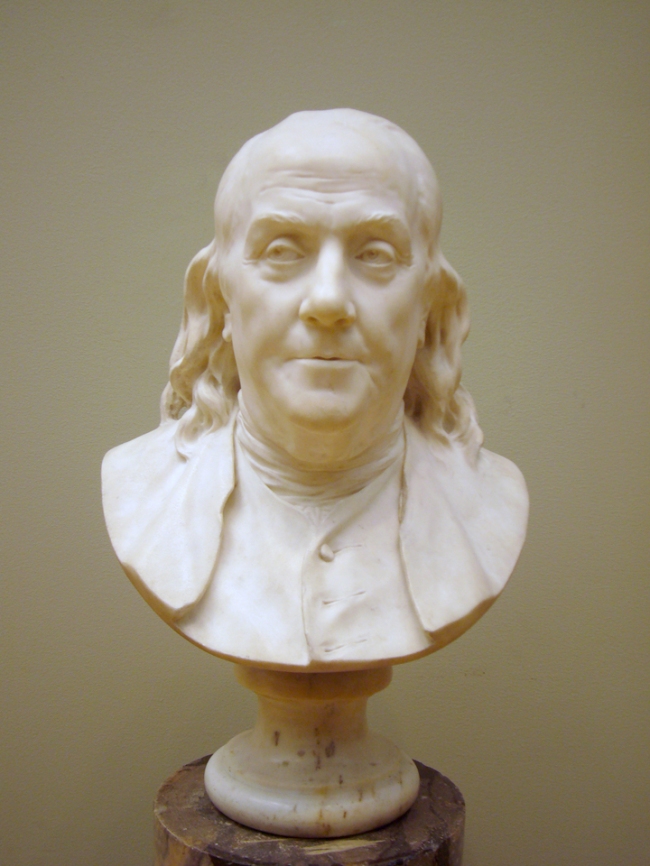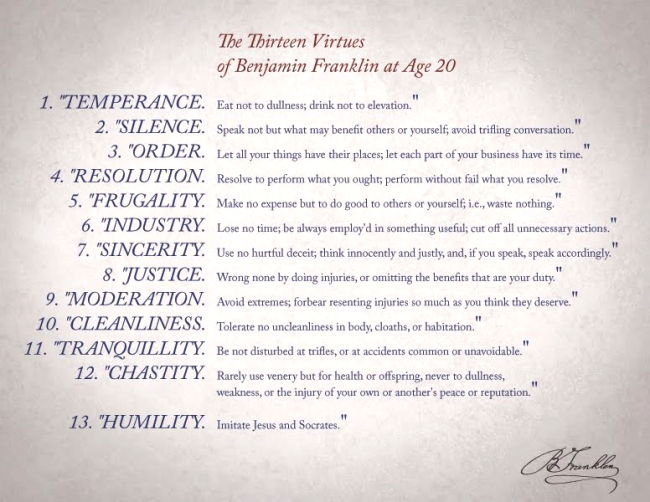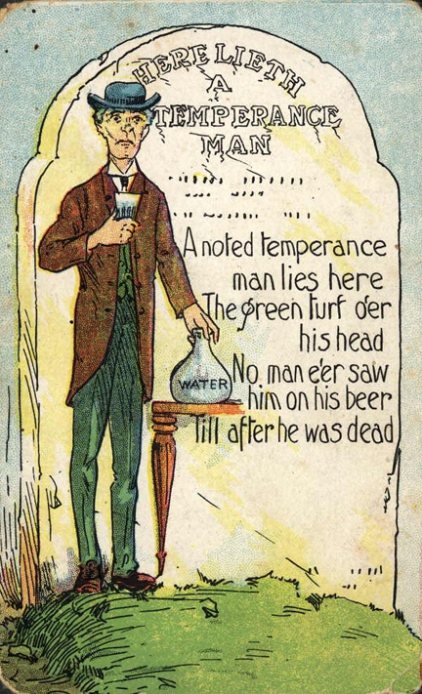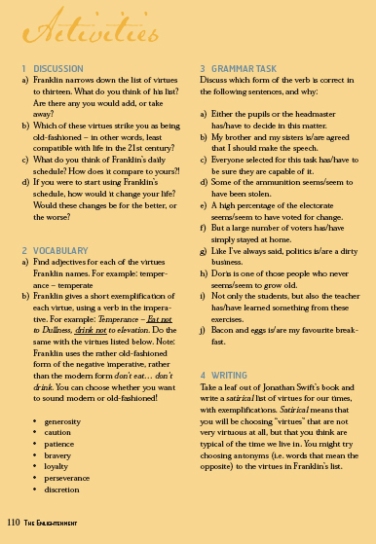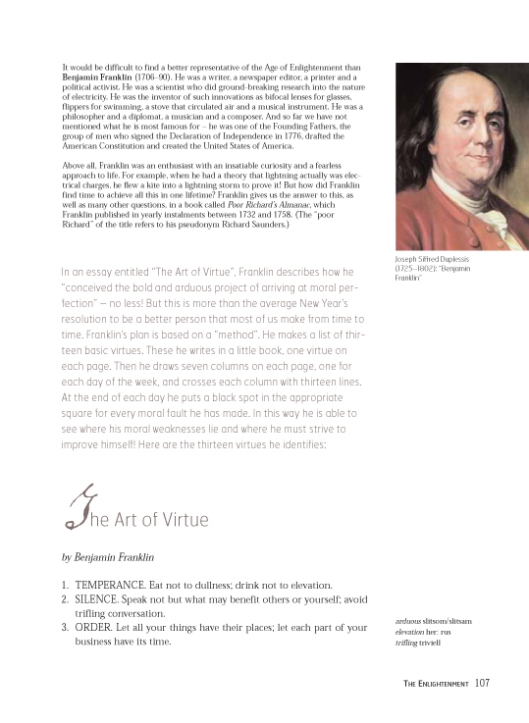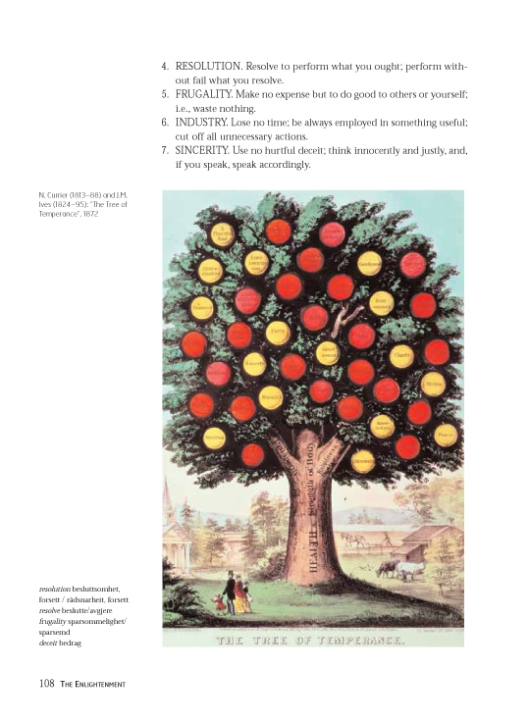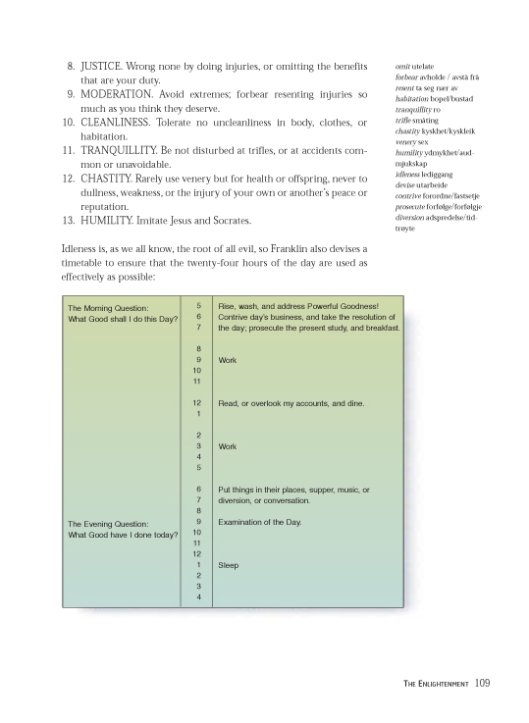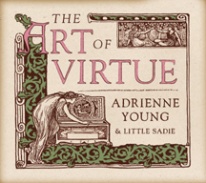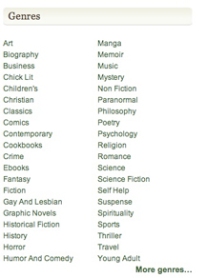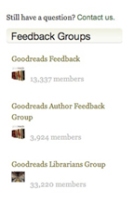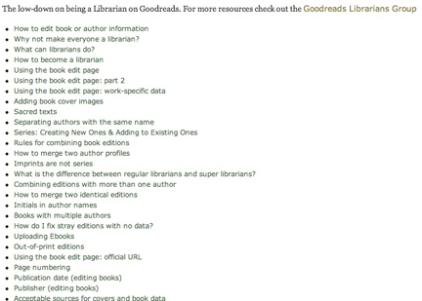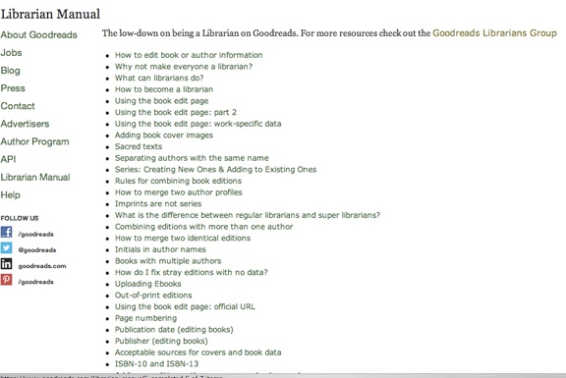Benjamin Franklin Forever (bff)
10/31/2013 § Leave a comment
Benjamin Franklin sought to cultivate his character by a plan of 13 virtues that he developed in 1726 at age 20 and continued to practice as ideals for the rest of his life. Franklin did not try to work on them all at once. Instead, he would work on one and only one each week “leaving all others to their ordinary chance.” While Franklin did fall short of these ideals many times, he believed the attempt made him a better man and contributed largely to his success, happiness, and mentorships. He devoted many more pages to this plan than to any other single point in his autobiography: “I hope, therefore, that some of my descendants may follow the example and reap the benefit.” (1)
Sculpted in marble in 1779 by Parisian artist Jean-Antoine Houdon (1741–1828), the Bust of Benjamin Franklin measures 21 x 13 1/2 x 10 inches. You can find it at Gallery 284 in the European Decorative Arts and Sculpture collection at the Philadelphia Museum of Art. http://www.philamuseum.org/visit/1-54-5.html?galleryID=284&accessID=1996-162-1v1-pma (2) What does it mean when a bust is created in remembrance of a public figure? Sculptors carve into marble when the object d’art is intended to endure and shine into eternity like Beethoven, Handel, or Mozart. From seeing the sculpture, it appears as though Ben whistled whilst he worked.
Living a virtuous life develops independence for any man or woman. This cannot be taken away, even if bound to captivity. A person with virtue has reason to give his best and prosper on a unique path. Virtue is relative to a person’s childhood. Franklin’s rewriting of an Alexander Pope line from his An Essay on Criticism looked like this: “Immodest Words admit but this Defence, That want of Modesty is Want of Sense.” (492) In other words, Franklin advises keeping things simple, within your reach and means, and use your language to rise and uphold your beliefs and you will grow.
About ten years before his proposal for a military academy for young men in Colonial America, Franklin wrote The Art of Virtue. He believed self-education is man’s private power and arranged his conduct to suit the whole of his life. Through living his life virtue , he maintained his integrity in personal and professional life in science and business. Through this belief, success came to him. Franklin was not captive to this life for he had plans and found reward.
Benjamin Franklin embodied the antithesis of captivity, a person committed to freedom of thought and expression with integrity. His primary reason for compiling this list of virtues was to establish a routine to develop a work ethic for youth.
Thirteen Virtues
The essence of Community Service
http://gregghake.com/2010/02/the-art-of-virtue/
Gregg Hacke’s Blog
What was the value of community service to Benjamin Franklin as a young man? Perhaps it was the example when he led his friends into stealing stones to build a wharf. (Norton, 985) Although this was play, his father scolded him with “nothing was useful which was not honest.” His father demonstrated his example of virtuous living through a solid understanding of judgment in prudential matters of private and public affairs. For Gregg Hacke’s blog, a young person might consider the virtues—frugality, industry, sincerity, tranquility, chastity, and humility—when finding a role in serving a community. No, we don’t get paid for all work efforts, not even half of them. The essence of community service reinforces the ideals of virtue that are key a component to any stage in adulthood, particularly for young adults. Similar to Erik Erikson’s stage five of psychosocial development, we attain self-actualization at a critical stage in life, the sooner the better. Consider these virtues in regards to community service: Frugality, industry, sincerity, cleanliness, tranquility, chastity, humility.(4)
Goodreads
https://www.goodreads.com/book/show/124166.Benjamin_Franklin_s_the_Art_of_Virtue?from_search=true
Goodreads is simply an extension of the library, a post-modern mesh of titles, covers, synopses and links for download. The rules and fees are simple, just like at a municipal outpost for books. Franklin established the first public library in Philadelphia. This legacy of knowledge through an infinite collection of information brings friends, colleagues, teachers, students, and public servants together in ways Franklin might have imagined as he explored the dawning of electricity.
The Goodreads summary: Benjamin Franklin was one of the greatest American minds of the 18th century, and his goal was to be a doer of good and to live a useful life. His dedication to principles of self-improvement and his belief that these principles could be beneficial to all led him in 1760 to “propose … a little work … to be called The Art of Virtue”. Though Franklin never completed the project, editor George L. Rogers has culled Franklin’s writings to assemble the book he might have written. The Art of Virtue is arranged according to twelve principles that guided Franklin’s life, including Franklin’s thoughts on goals and personal development, family and interpersonal relationships, business and wealth, ethics, good health, aging, and more.
The Art of Virtue is full of profound insight, delightful humor, quotable quotes — and plenty of common sense. Reprinted in 1996 by Acorn Publishing. 312 pages, paperback.
But one search at Barnes & Noble for Art of Virtue begets a variety of options for this contribution to the self-help genre of literature.
http://www.barnesandnoble.com/s/Art-of-virtue?store=book&keyword=Art+of+virtue
I found this title ranging from $3.74 used paperback for a young man to carry with him to a $41.65 (autographed??) hardback for the stodgy CEO coffee table to a $94 textbook from 2004.
http://www.barnesandnoble.com/w/franklin-benjamin-franklin/1100941128?ean=9780521834964
After Franklin sold his corporate printing shares, he explored the need for a philosophical society in Pennsylvania that would also fulfill the necessity of union and discipline for colonial defense. In 1744 America, a need for morality, intelligence, and civility were becoming necessary as tensions were building with Great Britain and tribes of Indians. This Website would have provided an interesting character building resource for those young minds.
Lessons in Manliness: This was the original intention of AOV for the young man.
Social Studies Activity
The list of virtues has different forms of artistic expression as a modern teaching tool. As a social studies unit on the Art of Virtue, this document exemplifies what Benjamin Franklin intended in crafting these ideals for livelihood. The apple tree of temperance allows both student and teacher to study this philosophy. The virtues are defined and explored as offered choices for living with summarizing questions in simple terms for reinforcement.
http://access-socialstudies.cappelendamm.no/
World Café recording
Adrienne Young preaches Franklin’s virtue ideals in terms of modern life through collective wisdom with her band Little Sadie.
LISTEN!
In 2005 songwriter Adrienne Young recorded an album of folk songs entitled Art of Virtue with her band Little Sadie. Her position on virtue shines through with tranquility, frugality, sincerity, and moderation. The album made the Amazon’s list of top records in genre for that year. Lyrically, she adapts Franklin’s 13 ideals and how people need to live independently and hold onto simple truths to navigate the long life ahead. The title track, written with Will Kimbrough:
Gonna start a revolution,
Made of action, not of words
Practicing the Art of Virtue
A joy ride on the learning curve
Gonna keep my eyes wide open
Till I have something to say
Start to put my house in order
Save some money for a rainy day
Gonna do just what I ought to
Finish what I say I’ll do
Spend my time on something useful
Worry less and speak the truth
I’d like to learn some moderation
Know just when enough’s enough
Meditate on being tranquil
Injure none and bear no grudge
I let go of my resistance
Son of God is inside me
I’m waitin’ for the real thing, honey
Ain’t nothin’ wrong with chastity
If I could walk the path of Jesus
Live each day the best I can
Follow in those humble footsteps
I might reach the promised land
Gonna start a revolution
Made of action, not of words
Practicing the Art of Virtue
A joy ride on a learning curve
Come and join this revolution
Made of action, not of words
Practicing the Art of Virtue
It’s all the rage, oh have you heard?(6)
Her music lyrics appeals to folks who pursue a simple life of virtue on attainable levels. She does not preach, but she does ask for you to join her.
Listen at the 5:30 mark from the 2005 World Café recording. The song “The Art of Virtue” lasts until approximately the 11:00 mark.
http://www.npr.org/templates/story/story.php?storyId=4944809
This next artifact demonstrates a little thievery. GRO, The Golden Rule, a not-for-profit site sells the list of virtues in a self-help book. The site suggests that visitors ask their spiritual guidance rep to help. The management does not want the role pf spiritual guide, but to offer new members personal growth. They have teachers and counselors promoting the values of the 13 virtues. The site appears to be for those lacking a spiritual path, but holds limited accountability, like a cult or quasi-sect.
It’s marketing—Benjamin Franklin Quotes, Unique Secrets for Success in Relationships, Personal Prosperity & Self Improvement, Benjamin Franlin’s secrets to relationships and personal success. “Our Benjamin Franklin Workbook includes his original unfinished work, updated for today’s challenges in a self-help book by Margaret Gedde MD, PhD. Easy, step-by-step methods to make your life, and the lives of others better & happier.”(5)
The New $100 bill
Counterfeit money in both legit and black international markets has created the need for a new $100 bill. On the upgraded design with Franklin’s iconic visage, Newsweek called it a creepier portrait, as the eyes seem to rise from the print. This money has color enhancements with the liberty bell, quill, and inkwell. It reminds me of how some foreign currencies have always looked—not like greenbacks but more colorfully historic as a printed piece, the bill is a marvel, right down to the changing of the clock on Independence Hall, from 4:10 to 10:30.(7)
Changes to the bill to protect it against counterfeit pressing by the unvirtuous include:
The $100 bill visage:
What does this image symbolize in 2013? From his beginnings as a wondrous boy in his father’s soap and candle shop, working with forms and molds discovering the process of production, manufacturing, and science, to his perseverance as a printing apprentice and scholarly writer of politics and ethics, Benjamin Franklin held to his 13 virtues. He never published them as standards but adhered to them throughout his life, knowing that all men are infallible. Franklin had the privilege of intellect but his wealth rose from the truth—the printed truth. His successful path connected to business deals, partnerships, investments, handshakes, and loyalty in moderation. Franklin was just one man, a leader by example but not by marriage to the task.
As I compiled the Web artifacts, it was easy to spot his legacy at work through printings and effective use of digital media. The Goodreads library alone is a symbol of this legacy with more than 700,000 titles in just six years. I question the integrity of the online counseling school, Golden Rule, and its list of virtues, even as a not-for-profit. But this is small potatoes compared with the reprinting of the $100 bill and Benjamin Franklin’s timeless image, observing without judgment, as this bill is passed around our globe in trade for goods and services, whether just or unjust, for deeds both evil and virtuous.
[ for my father ]
_____________________
(1) Franklin, Benjamin. Autobiography (Part Two) The Norton Anthology of American Literature, Beginnings to 1820, Vol. A. 8th Ed. Ed. Wayne Franklin, Philip F. Gura, et al. New York: Norton, 2012. (526-527). Print
(2) The Philadelphia Art Museum, Philadelphia. Permanent Collections, European Art 1500–1850. Web. 2013.
(3) AM Richardson. Benjamin Franklin’s 13 Virtues. Autopoesis. weebly.com. Web. October 18, 2012.
(4) Cherry, Kendra. Psychosocial Theories, Identity Versus Confusion. About.com, Psychology. Web. 2013.
(5) The Golden Rule Organization. Ben Franklin Quotes. Web. 2002-2012.
(6) Young, Adrienne. Kimbrough, Will. Art of Virtue. Art of Virtue, Addiebell Records. Nashville, TN. 2005. CD. http://www.cowboylyrics.com
(7) Ben Franklin’s Face Lift—the New 100 Bill. Businessweek, Articles, May 16, 2013. Web.
(8) Franklin, Benjamin. Autobiography (Part Three). The Norton Anthology of American Literature: Beginnings to 1820. Vol. A. 8th Ed. Ed. Wayne Franklin, Philip F. Gura, et al. New York: Norton, 2012, p. 485, 492. Print.
Texting for Life
10/27/2013 § Leave a comment
What factors do you think make texting such a popular communication tool activity among young people? In what ways might texting, with its improvised spelling, promote or hinder the development of children’s and adolescents’ reading and writing skills?
“KK” I still don’t really know where this comes from when my 12-year-old daughter sends me this but I don’t have to question its affirmative nature.
The challenge as a teacher and parent, how will I connect to this vernacular? A high percentage of adults (teachers and parents) text with a regular frequency. It is not a great leap for teachers and students to text. But there is a limit to the amount that a teacher can respond to that is why for now I don’t think it’s a great idea for students and teachers to text. Email is more effective for formal, official communication.
According to the text book, for school-age adolescents (what does this mean), text messaging is the predominant form of online communication—teens would rather text than talk on phones (Lenhart, 2012a). In 2011, the average teenager sent some 3,339 texts a month, more than six for every hour they were awake. (Nielsen, 2011). There is increasing use of smartphones as the technology is more cost effective. Most parents agree that mobile phones are essential and most students find it “important” for them to have the latest, most powerful phone technology (Lenhart, 2010). Girls send more text messages than boys.
Through texting, youngsters have opportunities to develop phonological awareness, use of printed words, and standard literacy in English. Research in England found that use of textisms was positively, not negatively, related to gains in reading proficiency among children age 10 to 12.
The challenges to a teacher: 1. Reinforce good communication habits. 2. Talk! 3. Create lessons from this, find a texting conversation, now rewrite it as a short story with proper introduction, correct usage, proper salutation.
http://littlethingsbigstuff.com/wp-content/uploads/2012/11/photo.png
Who are the people communicating? What is their relationship? What is this story about? What happens next? Develop proper communication skills with students, for the time will come when they will write term and letters. Texting has value as storytelling.
Texting and regular two-way communication are essential tools for teens and pre-teens, as lifelong socialization skills. Today, I text regularly with a friend from childhood with whom I once passed notes in middle school, decades ago. It is much the same today as it was 30 years ago. It is intuitive communication. Sometimes risqué, our respective children might see this now. The point is, things don’t really change and adults can’t pretend that teens are too young to experiment with communication.
At this age, as they enter secondary education, teens are building trusting relationships that might become lifelong friendships. Trust and support are essential while gossip and the chance of a bully are ever-present. Teens also experiment on “pushing the envelope” to save their social communication for free time and lunch time. This is also human nature. We must interact. We must learn to prioritize. Teens (adults too) will use any available opportunity to interact with a “besty”—between classes, during homeroom, after school, and in the evenings—after the schoolwork is complete of course. It’s not really fair for parents to say no, for they were (hopefully) doing the same when they were young—only with a different medium and unique social network.
It’s important that teens and pre-teens are not defensive about sharing the nature of the message when an adult, teachers included, sense a change in emotional behavior. Privacy is important, but bullying and gossip can be major distractions that can occupy a child’s mind for days and may lead to depression and a slide in school performance. Young people need to know that they can share messaging when necessary and trust that will be kept confidential with an adult. Teens are accustomed to limited privacy through supervision and at some point hormones and interests will change. But this development curve is wavy.
What if the following series of clips occurred in real life and were followed with texting interactions seeping into a social network. Imagine the social communication that would have surrounded this episode?
Diary of a Wimpy Kid, pool scene
http://www.youtube.com/watch?v=R2VHWdec4h8
Imagine if texting were a part of 70s youth
http://www.youtube.com/watch?v=VWXgANEH5gs
What if these kids had text messaging? Wonder Years
http://www.youtube.com/watch?v=Po5-0MQBFb0
When I watch television with my daughters in 2013, I never see the characters text messaging or even e-mailing on the Disney Channel’s Austin and Ally, Shake It Up, and A.N.T. Farm. What if they did? Boring! No, these characters exemplify children communicating through traditional and creative methods. I think this is a positive trend for children to emulate. And these shows on Disney carry a broad cross-section of kids (Age, weight, race, etc.). Dog with a Blog might just be the closest thing when the viewer sees the signature character summarizing the theme of each episode sitting at his computer; but he is a humorous, one-lining dog. In modern television programming for teens of sliding age scale, viewers do not see regular portrayals of kids interacting through text messaging. It’s just not interesting and the cool factor is in real life. The greatest value of young people on television is that they model excellent spoken communication for young people!
So many games and limited time
10/19/2013 § Leave a comment
Exploring problem solving with software, apps and games.
My generation, the one historically called Generation X, contributed generously as consumers to one of the greatest developments in the field of electricity as entertainment, the video game. When I was age 12 in 1981, arcade games were an electronic extension of the pinball machines and foosball tables, developed by software engineers in a growing market with $8 billion in revenue. Eagerly drawn to this, I had no idea of its addictive qualities and benefits to critical thinking and problem solving. The only game that really mattered to me was Centipede by Atari. The rest of these pioneers in video game development were a fun competition with friends but not worth mastering. (Donkey Kong, Pac Man, Space Invaders, etc.)
Worldwide, an average Centipede machine brought in $225 per week in 1982. (KPIX TV, San Francisco) Not small television consoles with nylon cords and action buttons, not a plastic Nintendo DSi, not an Xbox or a touch screen kindle, but a free-standing, floor-to-ceiling behemoth like a voting or telephone booth that facilitated an escape for the human brain to a different world in a public place.
A perfect video moment of the vibrant game market provides a vivid description. Its focus on Centipede begins at the 2:45:
http://www.youtube.com/watch?v=G_eGHDJ9igA
Physically moving my shoulders, craning my neck, shifting my legs and feet while virtually shooting dancing spiders and dropping fleas, I zapped at flashing lateral scorpions while eliminating stubborn mushrooms. The namesake arthropod would zig, zag, and drop across the screen, starting as a 13-segment creature and evolving into thirteen separate heads before resuming its initial being. In this way, the game was infinite.
http://www.youtube.com/watch?v=Co6ZvXIS7r4
Standing at this interactive terminal with four quarters or less, I could play a game for hours and use the senses—hearing, touch, an olfactory mix of electronics, people, Godfather’s Pizza and coins—and the fast reflexes required to navigate the game. On more than a few Saturdays or weeknights, I owned a game for a good hour until finally running out of lives, succumbing to its hypnotic menaces. I once purchased a book on how to become a champ. Look at its cover!
http://www.steverd.com/whatbook/bk-howtomaster.jpg
I became a champ if only to my own astonishment. By age fourteen, I was the second best player in my town of 26,000, second only to a high schooler with whom I dueled a couple of times or who would let me finish his game. I was just a kid whose mom had left him at the at the Aladdin’s Castle or Land of Oz arcade while she went mall shopping or one who hitched a ride in a car with an older teenaged friend. My mother would say I was gambling but would help with quarters anyway. My father was completing his PhD studying stress and heart disease and their connection to Type A and B behaviors. I was sharpening my brain and its attention span as if I was reading, playing a musical instrument, performing math problems, visualizing photosynthesis or thinking about indigenous cultures.
My high score as a teen was about 500,000. I would not exceed this until seven years later on a boardwalk at the Jersey Shore, where I had a summer job and vacation time to spend whiling away the hours, testing my mental reflexes, enjoying the game at the stationary console with the scent of Sicilian pizza and jealous cries of seagulls, while a Ferris wheel spun its carnival madness nearby and I blasted my way to a high score of 750,000 with no one around to care.
Educational games, apps, and software programs are becoming more effective at delivering higher order thinking. The best games have complex storylines, open-ended activities, and meaningful age appropriate characters that become learning companions for game players. These games also contain real-world settings that include complex puzzles to be solved during game play. Game players need to interact with virtual characters as they play the game, with opportunities for replaying the game to different outcomes. Kids are engrossed with interesting and engaging graphics and the capacity for to zoom in and out of different game spaces (John Rice, Higher Order Thinking Rubric, University of North Texas, 2007).
Students have electronic game access in a variety of formats from iPods to smart phones to kindles, and laptops and desktops. The myriad of math-based tutorials for any age is lengthy.
http://www.greatschools.org/students/media-kids/1585-high-tech-math-tutors.gs
Even Minecraft has mathematical merit through cyber-constructing and viewing. As a diversion, it still shows students how video games are formed based on pixels and cubes.
CreateSpace.com
What happened to advanced word searches and crossword puzzles (yawn!) and the hot and valuable trend of kids playing Sudoku? These traditionally involve paper and less “social” interaction. But action, fantasy, and role-playing are constant ingredients to the mix of how developers create educational systems. The Forbes top 10 listing demonstrates the buying habits for gamers.
http://www.forbes.com/sites/erikkain/2013/07/05/the-top-10-video-games-of-2013-january-june/
What are some opportunities for this in my reading classroom?
I don’t see much use for electronic games to supplement my teaching. Electronic word games are beneficial for younger children, especially in early childhood education. http://www.getreadytoread.org/ For my reading environment in secondary education, most software and app use will apply to the formation of research and essay construction using the Internet in its pure form with the power of Microsoft Word, blogsites, Visio, and PowerPoint.
A critical component of video games should always be in building critical thinking through Bloom’s Taxonomy classification. The original list for education built on knowledge followed by comprehension, application, analysis, synthesis, and evaluation. Educators have since revised this list to remembering, understanding, applying, analyzing, evaluating, and creating. [Anderson & Krathwohl, 2001) It is essential for young people to build on knowledge and use this to prepare for adulthood in an uncertain world. We must lead students to self-discovery and how to create independence and opportunities for success. Kids need both analytical and holistic approaches through schooling. This is a great challenge for educators in the technological age.
Goodreads—good for today and even better for tomorrow
10/06/2013 § Leave a comment
Share your findings on one of the social bookmarking resources from Chapter 6.
Launched in Jan. 2007, Goodreads is a network of more than 700,000 titles and a link between friends and authors. With a direct link to Facebook, Twitter, Pinterest, and LinkedIn. As a social media, members can create their own “literary” self, and review books to share with friends and see what they are reading. They can follow this with tracking books they are reading, have read, want to read, and making personalized book recommendations. Through the site’s community reviews, a teacher can find out if a book is a good fit for the class.
Together, Otis and Elizabeth Chandler launched the site in 2007 on the philosophy of “when I want to know what books to read, I’d rather turn to a friend than any random person or bestseller list. And on this journey with your friends you can explore new territory, gather information, and expand your mind.”
Members create virtual bookshelves to organize books you have or will read, give a rating, comment on each other’s reviews, and find their next favorite book.
As a teacher I can use Goodreads to build a bookshelf, or library, for students and provide a preview of the school year to come. This builds excitement through interactive graphics and links to new worlds in literature. I can also find or create groups to share with students or teachers.
Groups are organized by genres for easy research and selection:
Goodreads is a booming online enterprise linking readers to sales of printed and digital literature and owes its success to a network of friends who pick up lengthier readings. The Explore pulldown button on the site’s banner has a page with 2,500 eBook titles for download and a member can list by most downloaded, popular books, recently uploaded, for sale, highest price, and lowest price. Also under the Explore pulldown is a link to Creative Writing for members to post short stories, chapters, poetry, or whole books.
If a member is logged into Facebook, username and password is not required for Goodreads. After easy log in and navigation, a swift search brings just about any title they want. The log in area has an icon prompt for notifications, inbox, and friend activity.
Teachers can demonstrate proper online communication with their students and extend their reading classroom environment in the Goodreads library. True, there might be other email sources within a school and the addition of one more might be cumbersome. But, to keep a focus on literature and fully utilize this robust web site, this option is there. Plus, students can visualize what they and their friends have read and hopefully take ownership for a lifetime of reading.
The site is clean, highly functional, not laden with superfluous images and sound. With a neutral eye-pleasing color scheme for its community of readers, a browse of the site and staff page maintains the confidence that the member has in sharing his literary taste. For students browsing the whole site, they should feel this same camaraderie and know that it is a safe environment. It is a library and quiet zone.
If I should need to expand class’ interaction with the Goodreads site, the Help page at Goodreads is openly hospitable with answers to most every question in simple and helpful terms, like a library. The amazing help page has categories of: my books, book topics, my account, iPhone, mobile, groups, friends, facebook, giveaways, ebooks, privacy, author program, recommendations. It is highly capable of steering the user rightly but in the process demonstrates full and expert use of the media.
Goodreads has over 50,000 members to provide feedback on any topic.
For members who want to increase their adventure in reading, research, and literary Web site navigation, Goodreads always needs librarians to help integrate their site. If students should choose to investigate this site more deeply, these links are a valuable scope to managing literature. And these standards can help build a curiosity to things like style guides for essay writing throughout a reader’s life.
GoodReads is coming to new Kindle Fires
“No surprise that many involve social media, which tends to be low in cost and high in manpower. It’s sometimes difficult to gauge the benefits of such promotions,” according to Coach House Books publicist Evan Munday. Nearly half their media list is now dedicated to digital — ‘bloggers, websites, readers who talk a lot about books on Twitter and Facebook,’ he said. They routinely send advance-reading copies to a few Amazon buyers.” (Toronto Star, March 8, 2013)
The company currently has 16 openings in site engineering at its headquarters. They urge members to apply to their friendly environment, but if you must live in the San Francisco Bay area.
Beauty and The Beast
10/03/2013 § Leave a comment
(An ekphrastic poem on an oil painting by Betty Schmidt)
http://bettyschmidt.com/dataviewer.asp?keyvalue=1340&subkeyvalue=1102230&page=WorksDetail
Ode to a Half Dome
Yosemite half dome
With Ansel Adams’ touch
Of majestic white granite
And pink mountainside blush.
To scale at its peak
and camp in its shadow
Mirror Lake shimmers with approval
At the foot down below.
The pines stand in eloquence
O’er God’s pristine meadow
And humankind eternal
Will bask in Heaven’s glow.
On that Chevy Pick-up
Behind the Silverado,
a menace beyond which I cannot see.
Ahead of the Silverado,
what the fuck is behind me?
A gleam of headlights, like a Stephen King Christine.
Mammoth, never dusty, always clean.
Urban cowboys in their rural scene.
Forever Bound
10/03/2013 § Leave a comment
The Details of this Search
I. In three years, what will my reading classroom look like?
Rows of books on shelves,
stock of same ol’ for dramatic reading:
Shane,
Hatchet,
Percy Jax,
Mockingbird,
City of Ember,
The Outsiders,
Lord of the Flies,
The Maze Runner
The Hound of the Baskervilles,
Adventures of Huckleberry Finn,
The Complete Tales of Edgar Allen Poe,
and a few bygone as taboo.
II. In three years, what will my students look like?
Peering ahead at hot type on a recycled pulp,
at new printings of antique text
in shiny anthologies
and footnotes
to render a Google’s curiosity.
Compare ye gods of Mediterranean lore,
to Celtic and Norse,
th’ancient legend
for classroom discourse.
III. In three years, my students, what will they see?
Kindles and iPads,
a scroll of text for stationary pupils–
Dilated.
Thumbs up to the next screen,
sweeping aside,
indexing to a distant plane
of interactive life.
With links to a past or
some new print like a cast,
o’er yonder rows and stacks
of fractured expired tabs.
(11/12/2013)

